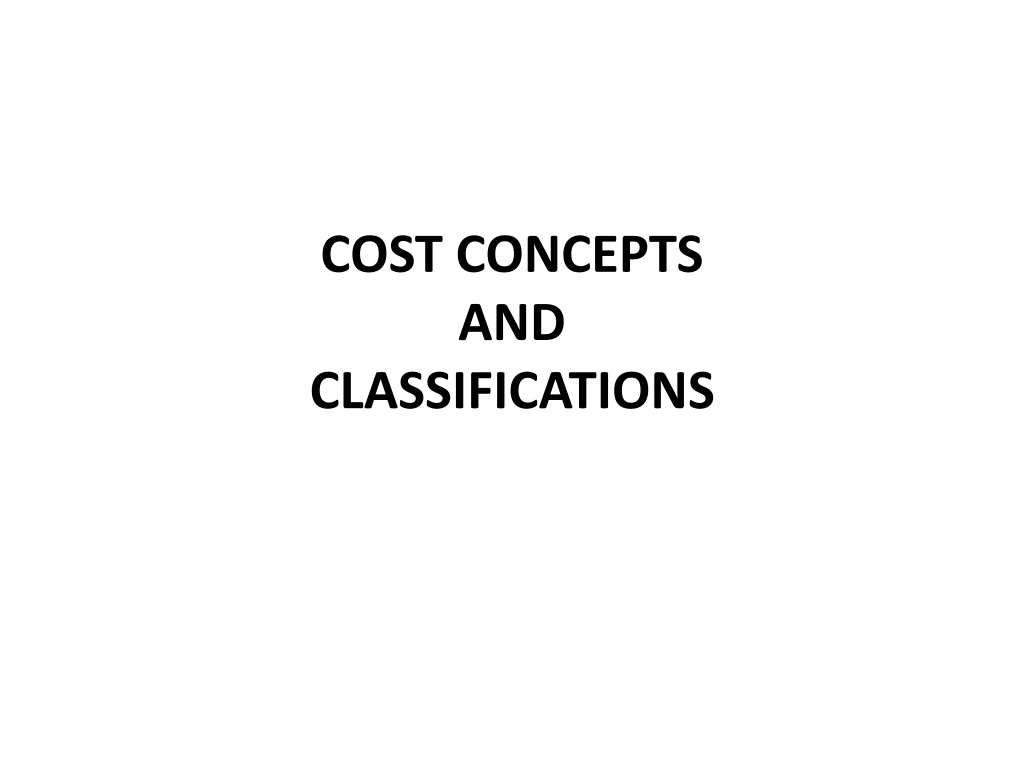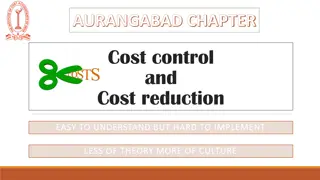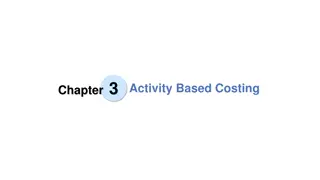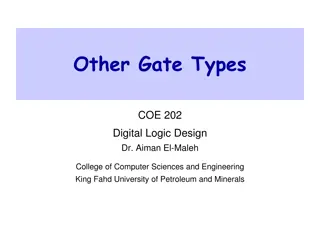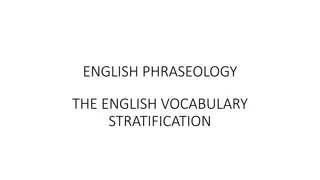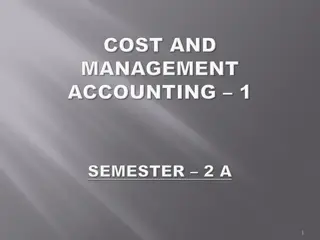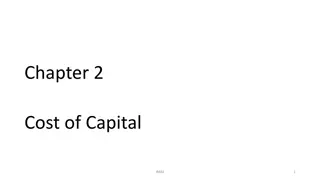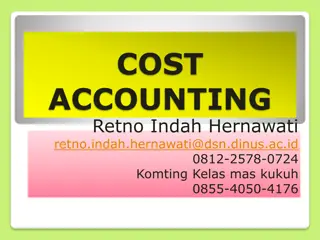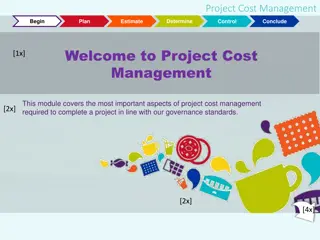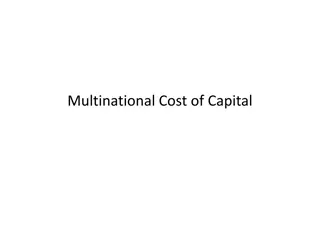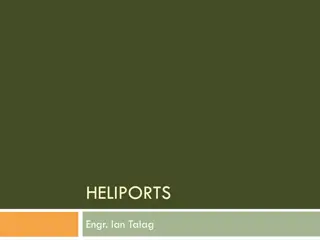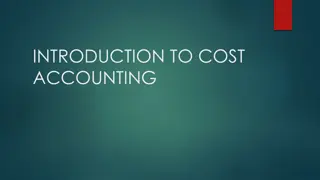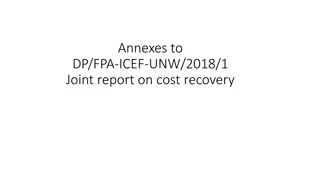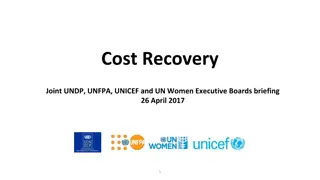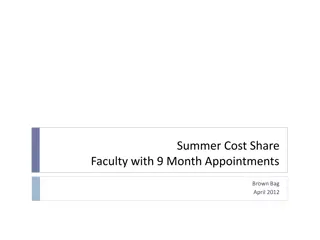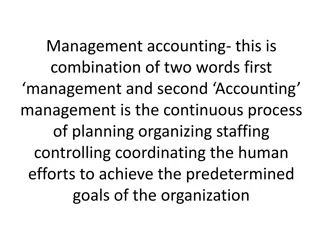Understanding Cost Concepts and Classifications for Effective Management
Explore the definition of cost, various cost classifications, elements of cost, and the preparation of cost sheets for managerial use. Delve into fixed and variable costs with examples from manufacturing jeans, highlighting the importance of managing costs in organizational operations.
Uploaded on Sep 15, 2024 | 1 Views
Download Presentation

Please find below an Image/Link to download the presentation.
The content on the website is provided AS IS for your information and personal use only. It may not be sold, licensed, or shared on other websites without obtaining consent from the author. Download presentation by click this link. If you encounter any issues during the download, it is possible that the publisher has removed the file from their server.
E N D
Presentation Transcript
COST CONCEPTS AND CLASSIFICATIONS
In this session we shall cover Definition of cost How can the different costs be classified for use by managers? What are the different elements of cost? What is a cost sheet and how is it prepared?
Cost concepts and Classification An management understanding of various types of costs incurred by the organizations and how these costs are actively managed An understanding of cost concepts and classifications enable accountant to provide appropriate cost data to the managers as and when they need it important first step in to studying gain accounting is an the managerial
Defining Cost Cost is defined as a sacrifice made, usually measured by the resources given up, to achieve a particular objective
Variable and Fixed cost Variable cost Example - In manufacture of jeans, Basic raw material is denim Cost of denim = Rs 500 / metre 1 jeans require 4 metres of denim
Variable and Fixed cost Variable cost Example - In manufacture of jeans, Basic raw material is denim Cost of denim = Rs 500 / metre 1 jeans require 4 metres of denim Level of Production Raw material required Cost of raw material
Variable and Fixed cost Variable cost Example - In manufacture of jeans, Basic raw material is denim Cost of denim = Rs 500 / metre 1 jeans require 4 metres of denim Level of Production Raw material required Cost of raw material 1000 jeans 4000 metres Rs 2 million
Variable and Fixed cost Variable cost Example - In manufacture of jeans, Basic raw material is denim Cost of denim = Rs 500 / metre 1 jeans require 4 metres of denim Level of Production Raw material required Cost of raw material 1000 jeans 4000 metres Rs 2 million 2000 jeans 8000 metres Rs 4 million
Variable and Fixed cost Variable cost Example - In manufacture of jeans, Basic raw material is denim Cost of denim = Rs 500 / metre 1 jeans require 4 metres of denim Level of Production Raw material required Cost of raw material 1000 jeans 4000 metres Rs 2 million 2000 jeans 8000 metres Rs 4 million 500 jeans 2000 metres Rs 1 million
Variable and Fixed cost Variable cost Example - In manufacture of jeans, Basic raw material is denim Cost of denim = Rs 500 / metre 1 jeans require 4 metres of denim Level of Production Raw material required Cost of raw material 1000 jeans 4000 metres Rs 2 million 2000 jeans 8000 metres Rs 4 million 500 jeans 2000 metres Rs 1 million 0 0 0
Variable and Fixed cost Variable cost The total VC changes in direct proportion to the change in the level of business activity or output However, it remains fixed on a per unit basis even as the level of activity changes
Variable and Fixed cost Variable cost The total VC changes in direct proportion to the change in the level of business activity or output However, it remains fixed on a per unit basis even as the level of activity changes Cost VC Level of output
Variable and Fixed cost Fixed cost Example - For manufacturing jeans, A factory premises is taken on rent Rent / month = Rs 1,00,000
Variable and Fixed cost Fixed cost Example - For manufacturing jeans, A factory premises is taken on rent Rent / month = Rs 1,00,000 Level of Production Rent paid Cost of rent / unit
Variable and Fixed cost Fixed cost Example - For manufacturing jeans, A factory premises is taken on rent Rent / month = Rs 1,00,000 Level of Production Rent paid Cost of rent / unit 1000 1,00,000 Rs 100
Variable and Fixed cost Fixed cost Example - For manufacturing jeans, A factory premises is taken on rent Rent / month = Rs 1,00,000 Level of Production Rent paid Cost of rent / unit 1000 1,00,000 Rs 100 2000 1,00,000 Rs 50
Variable and Fixed cost Fixed cost Example - For manufacturing jeans, A factory premises is taken on rent Rent / month = Rs 1,00,000 Level of Production Rent paid Cost of rent / unit 1000 1,00,000 Rs 100 2000 1,00,000 Rs 50 500 1,00,000 Rs 200
Variable and Fixed cost Fixed cost Example - For manufacturing jeans, A factory premises is taken on rent Rent / month = Rs 1,00,000 Level of Production Rent paid Cost of rent / unit 1000 1,00,000 Rs 100 2000 1,00,000 Rs 50 500 1,00,000 Rs 200 0 1,00,000 NA
Variable and Fixed cost Fixed cost: It remains unchanged in total even as the level of activity varies However, FC/unit decreases with an increase in the level of activity
Variable and Fixed cost Fixed cost: It remains unchanged in total even as the level of activity varies However, FC/unit decreases with an increase in the level of activity Cost FC Level of output
Variable and Fixed cost Semi fixed / Semi variable cost: It contains the elements of both fixed and variable cost Example: The loss in value of fixed asset occurring both due to use and due to passage of time It does not vary in direct proportion to the change in the level of activity but also does not remain constant at all times
Variable and Fixed cost Semi fixed / Semi variable cost: It contains the elements of both fixed and variable cost Example: The loss in value of fixed asset occurring both due to use and due to passage of time It does not vary in direct proportion to the change in the level of activity but also does not remain constant at all times Cost Semi variable cost Level of output
Step cost Example - To supervise the work of labourers engaged in manufacture of jeans, foremen are employed One foreman can supervise only 20 labourers. Beyond 20, if the number of labor increase, additional foreman will have to be employed. For manufacture of every 500 pieces of jeans, 20 labourers are required The monthly salary of a foreman = Rs 20,000
Step cost Example - To supervise the work of labourers engaged in manufacture of jeans, foremen are employed One foreman can supervise only 20 labourers. Beyond 20, if the number of labor increase, additional foreman will have to be employed. For manufacture of every 500 pieces of jeans, 20 labourers are required The monthly salary of a foreman = Rs 20,000 Level of production Labourers required Foreman required Cost of foremen s salary 400 jeans Less than 20 1 20,000 500 20 1 20,000 510 21 40 2 40,000 700 21 40 2 40,000 1000 40 2 40,000
Step cost It remains fixed over a range of activity and then jump on to a new level as the level of activity changes Example: Here, the salary of foreman is a stepcost .
Step cost It remains fixed over a range of activity and then jump on to a new level as the level of activity changes Example: Here, the salary of foreman is a stepcost . Cost Step cost Level of output
Relevant and Irrelevant cost Relevant cost: It is the cost that can be impacted by a managerial decision Irrelevant cost: It is the cost that cannot be impacted by a managerial decision Example: In deciding whether to close down a retail shop, two costs are under consideration Salaries of salesman Prepaid rent which is non-refundable
Sunk cost Also called Historical or Past costs These are the costs that have been incurred in the past, and cannot be changed or undone by any current or future action As they cannot be altered by any subsequent action, they are irrelevant for decision making
Sunk cost Example: A computer was purchased to assist the work which was manually done earlier. A year has passed and the computer s warranty has expired. The computer is now not working well. An investigation reveals that this brand of computer is very sensitive to humidity and temperature changes. The office is located in an old building with poor air conditioning. As a result computer does not work properly and repair bills are also very high. The office manager suggests that the computer must be disposed off and the company should return to the old manual system The director responds by insisting, We cannot afford to junk the computer. We paid Rs 50,000 for it. What would the managerial accountant s response to this situation be?
Relevant and Irrelevant cost Rs 50,000 is a sunk cost and should not impact the decision to dispose off the computer or not. The decision should be based on the following future costs: Repair bills of the computer Cost of improving air conditioning Cost of doing work manually
Avoidable and Unavoidable cost Unavoidable cost: Also called Inescapablecost These costs cannot be eliminated but merely get reallocated if that discontinued with. Avoidable cost: It is also called Escapablecost These are the costs that can be eliminated if a segment of the business with which the cost is directly related, is discontinued. particular segment is
Avoidable and Unavoidable cost Example: Lets consider the following costs when one of the product lines is discontinued with, Salary of factory manager and factory rent, where all different products are manufactured together Bad debts attached to specific product line
Shut down costs If the operations of the business sought to be shut down temporarily on account of shortage of raw material, or labour strike, or some machine failure etc., the costs which will still have to be incurred, are called shutdown costs As such costs cannot be avoided, they are irrelevant for decision making to shut down or continue with the business operations Example: Rent of factory premises, which will still have to be paid, even when the production is temporarily stopped
Differential costs This is the amount by which the cost differs under two alternative actions It may occur as Incremental cost: i.e. the increase in cost from one alternative to another Decremental cost: i.e. the decrease in cost from one alternative to another
Opportunity costs Also called Imputed or Notional costs It is the cost of next best alternative i.e. the benefit sacrificed when the choice of one action precludes taking an alternative course of action Examples: When the proprietor of business choses to work for the business, he foregoes the opportunity to work elsewhere and draw salary therefrom When the business uses own property, it foregoes the opportunity to lease out the same and earn rental income therefrom When business uses internally generated funds, it foregoes the opportunity to invest the same amount and earn interest thereon
Out of pocket costs Also called Explicitcosts It is the cost that requires a present / future cash expenditure for a particular decision Example: If a company wants to replace own trucks with the public carrier of goods, Expenditure on fuel, maintenance charges etc. are out of pocket costs the business shall then have to pay for salary to drivers,
Joint and Common costs Joint cost: It is incurred in case of process industries where a single product cannot be independently produced Such costs are incurred as the nature of manufacturing is so, that out of the same process, two or more products are simultaneously produced It is the cost incurred till the split off point
Joint and Common costs Common costs: Such costs cannot be separately identified with individual product lines Thus these have to be apportioned on a suitable basis Example: Rent, lighting etc. of factory premises where multiple products are simultaneously manufactured
TOTAL COST Material Labour Expense
TOTAL COST Material Labour Expense Indirect material Direct material
TOTAL COST Material Labour Expense Indirect labour Indirect material Direct labour Direct material
TOTAL COST Material Labour Expense Indirect expense Direct expense Indirect labour Indirect material Direct labour Direct material
TOTAL COST Material Labour Expense Indirect expense Direct expense Indirect labour Indirect material Direct labour Direct material Overheads
TOTAL COST Material Labour Expense Indirect expense Direct expense Indirect labour Indirect material Direct labour Direct material Overheads Selling & distribution Factory Office & administration
Elements of cost Direct material It is defined as raw material that is consumed in the manufacturing incorporated in the finished product and can be conveniently assigned to the specific physical unit of output Example: Sheet metal in the manufacture of an automobile process, is physically
Elements of cost Indirect material It includes the cost of materials that are required for the production process but do not become an integral part of the finished product, i.e. cannot be identified with each unit of output Materials that do become an integral part of finished product but are insignificant in cost are also often classified as indirectmaterial May be used in factory, office or selling & distribution
Elements of cost Direct labour: It is the cost of salaries, wages and fringe benefits for persons who manufactured products Example Wages of persons who operate machine and equipment in the factory Employer paid health insurance premium, employer s pension contribution etc. for such employees work directly on the
Elements of cost Indirect labour: It is the cost of persons who do not work directly on the product, but whose services are necessary for the manufacturing process or for tasks incidental therein May be incurred at factory, office or sales level Example: Salary of storekeeper, foreman etc Director s fee Salary of salesman
